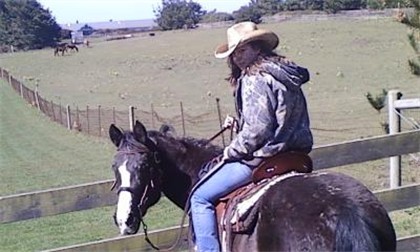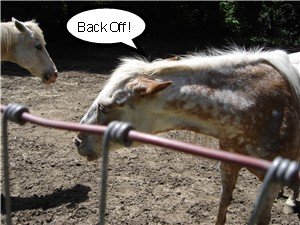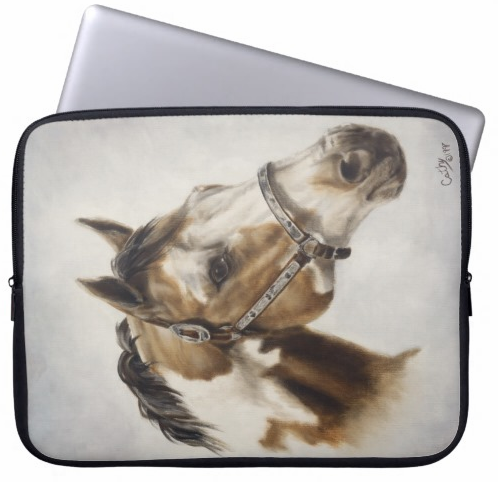Gaited Horses and Mules
with
Burl Brooks
 Burl Brooks Gaited Horse Trainer
Burl Brooks Gaited Horse TrainerMeet Burl Brooks aka Moose - Long time horse trainer and author, specializing in gaited horses and mules. Burl has spent a lifetime working with horses and has dedicated himself to training and teaching both horse and rider with Natural Horsemanship methods.
Over the years Burl has shown competitively on the TWHBEA, MATWHA, and FOSH gaited horse show circuits. Today he spends most of his time working one on one with horses and their owners.
When he's not training horses, Burl can be found writing, teaching at clinics and hosting guided trail rides in the Ozark Mountains. Though he works with all breeds, he's got a soft spot for the gaited ones. Brooks is joining us today to share some of his wisdom about gaited horses and mules.
Burl, how and why did you come to get started working with gaited horses and mules?
I was born at an early age…….wait, wrong story…… Actually, I WAS born on a small horse farm in rural Mo, here in the Ozark Mountains. My father was, and still is, a farrier and a trainer of gaited horses. I don’t remember when I started riding; I was just a tiny baby, not even walking when Dad first took my twin and I riding with him. It wasn’t long, however before we were putting the miles on horses for him.
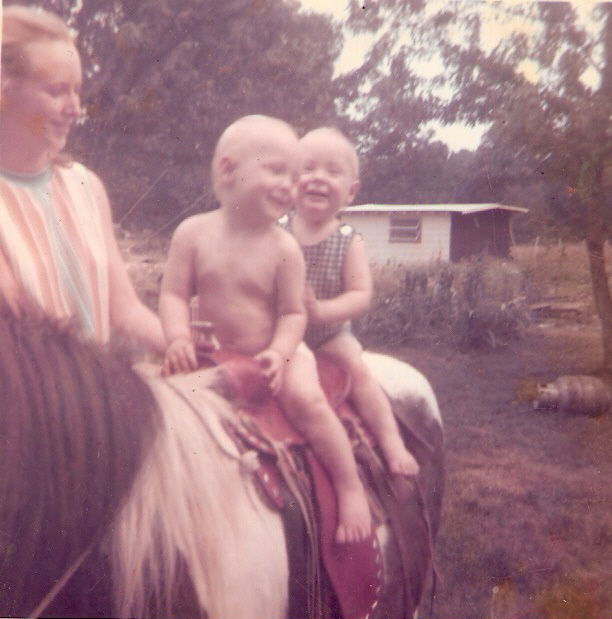 Burl and Mike Brooks started young Burl and Mike Brooks started young |
He would get them started, put a couple of rides on them, then Mike (my identical twin) and I would ride them to the river to play all day. We would ride all day, EVERY day if the chance presented itself to us. Dad taught us really early how to tell what gait was what and how to keep them in it. I didn’t start riding mules until much later. I was out of the Air Force, and married when a friend and neighbor asked me to take on a Missouri Fox Trotting Mule. He needed her ridden in advance of the trail season coming up. I quickly realized that mules were a WHOLE different ball game than horses. |
We really can’t get into the differences between horses and mules here, however, suffice to say that you have to be REALLY good at it to set gait in a mule. I’ve been working with mules ever since. I really enjoy them. Not only do I keep them trained, they keep ME well trained. They keep me on top of my game.
We've all heard of gaited horses, but many of us are not very familiar with them. How many gaits are there and what are they called? Do both the mules and the horses do all the same gaits?
To answer that, we first need to discuss the nature of the gaited horse. To start off we have to identify “gait”. Gait, in its simplest form is a means of locomotion. It’s how we perambulate, or get around. These horses have been bred for many years to produce a specialized form of movement which is called a gait. All horses have the same basic gaits; the walk, trot and canter.
However, your Missouri Fox Trotter, for example, has gaits in-between these standards. He has a walk, a flat walk (a faster, more animated version of the walk with more headshake), the Fox Trot (a diagonal four-beat gait) the Running Walk, and 'shudder' (a Pace).
There are many gaits, and each horse is bred for a specific gait, although some horses have been interbred for certain characteristics and can exhibit gaits known to other breeds. Other gaits include the stepping pace, the rack, the amble, tolt, corto, largo, and the list goes on and on and on. There are as many gaits as there are individual breeds of gaited horse.
Several years ago, we went to a clinic for one of the more famous horse training instructors that came into the area where I was training in Pennsylvania. After watching him work the horses, we managed to get an opportunity to speak to him afterwards, and we discussed breeds, and styles, etc. It was when he heard that we dealt with primarily gaited stock that he snorted. "Gaited horses are for amateur riders." was his exact response.
That was good for a bit of a laugh, but you know what, he was exactly right. He was not correct for the reason you may think though. Gaited horses are often by nature, even tempered and good natured animals. They are smooth of gait and easy to ride. So, yes, they ARE for amateur riders.
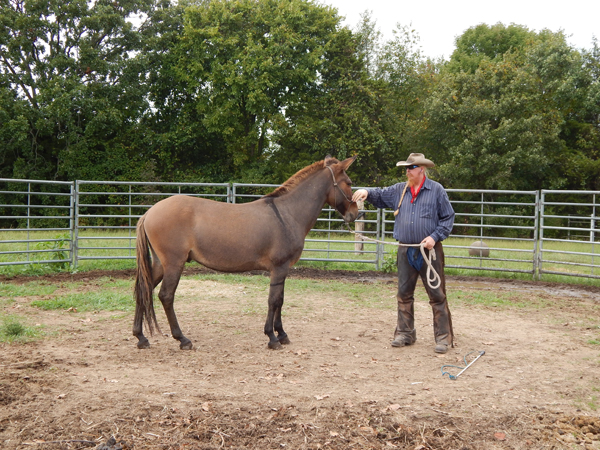 Mules are a little more challenging
Mules are a little more challengingThey are also for experienced riders who want a bit more out of their ride than bouncing up and down in the saddle the whole trip. We've ridden some good straight going animals, and they are good at what they are for. But for me, if I'm going to ride all day, I have a saying. "Go gaited or go home!"
Mules, though, are a bit different. They are a hybrid, so they often exhibit characteristics from both parents. I was told, recently that, "There is no such thing as a gaited mule." That is simply just not true. The problem with mules, if you want to call it a problem, I call it a challenge, is that they are VERY short strided. They get that from the jack. They will have gait, however as they are only half horse, they will not have the definition of gait like a horse. They can exhibit a lot of the same gaits as their dam, but not as clearly defined.
As a rider, what's the difference on a gaited horse? I mean, can I go straight from a non-gaited horse to a gaited one and run through the gaits, or do I have to know some special cues to ask for certain paces?
Yes, you can go from one to the other, but I recommend you spend some time getting to know the horse and his gaits before just jumping on and taking off. It is a whole different style of riding, requiring a different seat, meaning you have to sit differently in the saddle. It’s a deeper seat for a gaited horse, and there is no posting and no bouncing.
If your butt is bouncing up and down in the saddle, he is NOT in a gait. They are naturally gaited, which means they are born with it, but it’s a lot different when you put a rider on their backs. It changes the balance and their center of gravity. It’s up to us, the rider to help them adjust to our weight.
When you are working with a rider new to gaited horses, what's the biggest challenge?
One of the biggest challenges for folks that are new to the gaited horse is the lack of trot, and not having to post. Learning the gaits can be challenging as well for those who have spent long periods with straight going animals. I teach all my students to ride by ear, and to ride by feel. First, you have to be able to feel the difference in the gaits.
You have to be able to tell if he’s trotting, pacing, or if he’s in a desired gait. I compare it to music. Music has a beat, and the songs we typically like best have a strong driving beat. So do gaited horses. They will have a strong even four beat gait when they are doing it correctly. You will feel the difference. Next you listen for the foot falls. You can tell if it’s an even four beat gait, or if it’s broken, or two beat.
It’s often best to ride them somewhere that you can actually hear the hoof beats, preferably a gravel road or a sounding board if you have access to one. I do not recommend riding on black top. Unless you have your horse properly shod, this can be quite dangerous, as the pavement is very slick to anything but borium coated shoes.
You've been at this training business for a lot of years and I know you've seen many a horse and mule. Would you tell us a bit about the more memorable animals you've trained?
One of my favorite mules was a 16hh+ Walking Mule. His name was Sonny. He was such a talented boy. He was forever more gaited too. He had a walk to be envied, for certain sure. I started him under saddle as a three year old, and he was already topping 16 hands. He was hand raised and was as friendly as a dog. His talent was only surpassed by his willingness to please. I found the way to Sonny’s heart was to give him a job. If he was idle, he was hunting trouble.
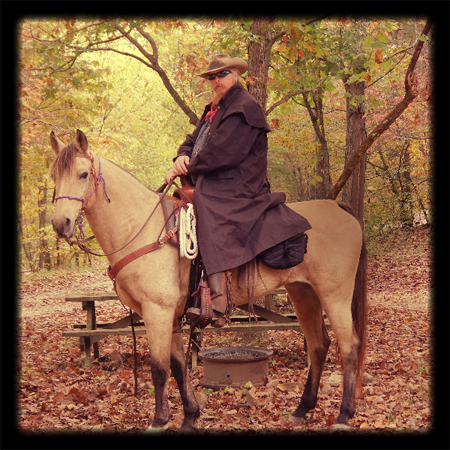
Sonny turned out to be one of the best trail mules I've ever had the pleasure to work with. He learned to neck rein, side pass, back, and to park or stretch out. He would cross the river, climb the hill and go over or through about anything you pointed him at. The funniest thing was, he would cross a river deep enough we almost had to swim it, but every mud puddle we came to had an alligator in it. I know for certain they did because he told me so, every time we came to one.
He would skirt it, jump it, and ignore it or just plain stop in front of it, until he was absolutely certain there were not gators in it. I TRIED to explain to him that he was the biggest derned thing in the woods, but he was having none of it. Eventually, he got over his crippling fear of alligators in the mud puddles, with the help of strong anti-psychotics and years of therapy with Dr. Phil.
I've ridden so many horses that it’s hard for them to stand out in my mind. However, if I had to pick my favorite, it would be my first horse. He went by the dubious moniker of Hobo, and I loved him more than summer vacation. That’s saying a lot for a kid. Hobo was an accident. He was half American Quarter Horse, and half Missouri Fox Trotter.
Born on our property, in rural Texas County, Missouri, he had little tufts of red hair sticking out from his otherwise black body. My mom took one look and said "It looks like a little bum! Let’s call him Hobo." It stuck. We rode miles and miles and miles together, and a truer companion a boy never had. He is actually featured in my book of poetry and prose.
Burl, I can't let you go without telling us about the two books you've written. You are a story teller at heart. Have you any plans for a third one? Maybe a compilation of adventures?
My newest book, 'Cinch Marks: Misadventures and Tall Tales From a Self Described Curmudgeon' was 20+ years in the making. It's about life and love and growing up in the Ozark Mountains of Missouri. When you open the cover and look at its contents, you are looking at my soul laid bare for the world to see. It's a book of poetry and stories inspired and taken from my own life experiences.
My other book is on horse and mule training and some not so common training tips and advice. I tried to approach 'Horse Sense' from the non-traditional stand point. You have a lot of good advice out there, whether it is in book form or on the ‘net, but I tried to put together a book that covered some things that maybe slipped through the cracks.
Thank you so much for taking the time to talk with us today Burl. It's been a real pleasure!
Visit Burl Brooks' Gaited Horse Training to learn more about his work with gaited horses and training methods. You can check out his books here.
More Equine Topics You May Enjoy
True Horse StoriesCheck out these fun true horse stories! Read about real life adventures on horseback. Bumper Stickers Equine themed bumper stickers perfect for your truck and trailer. |
Horse First Aid KitFind out what items you need to build a well rounded horse first aid kit for your barn, your truck and on the trail. Horse Hoof Anatomy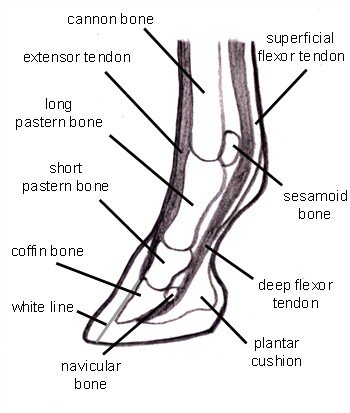 See horse hoof anatomy inside and out for a better understanding of your horse's feet. Draw a Horse HeadDrawing a horse - The Head. The head is simple to draw when you break it down into easy steps. Shop Horse Lovers GiftsFind fun and functional gifts for horse lovers inspired by the art work of Cathy Cleveland. |
